Museums and Filming Locations in the Bridgerton Series
Bridgerton premiered on Netflix in December 2019, breaking viewership records. The show set in Regency London was filmed at various locations...
Jimena Escoto 22 July 2024
31 May 2022 min Read
From the beginning of season 3 of Netflix’s The Chilling Adventures of Sabrina, Ms. Wardwell hits the nail on the head. As you will see below, the paintings she mentions serve as inspiration for portrayals of hell in today’s visual media, including The Chilling Adventures of Sabrina. During seasons three and four of Netflix’s reboot of the classic comic, Sabrina and her faithful coven of friends and witches take hell by Lucifer’s horns in order to restore order on earth. In the process, several portrayals of hell and other famous paintings make cameos.
Some of the world’s greatest artists have used hell as their subject in such an authentic way. It feels as if they somehow must have visited the place. Hieronymus Bosch, for instance, his paintings have been described as windows overlooking the hills of hell.
Mary Wardwell, S3E01, The Chilling Adventures of Sabrina/Netflix.
At the very beginning of season three, Sabrina and her friends return to school. Upon entering their classroom, they find a linear drawing (constructed only with lines, no color or tone) of the nine circles of hell on the chalkboard. Then, a frazzled Ms. Wardwell enters, announcing they will be focusing on Dante’s Inferno, hence the imposing chalkboard art.
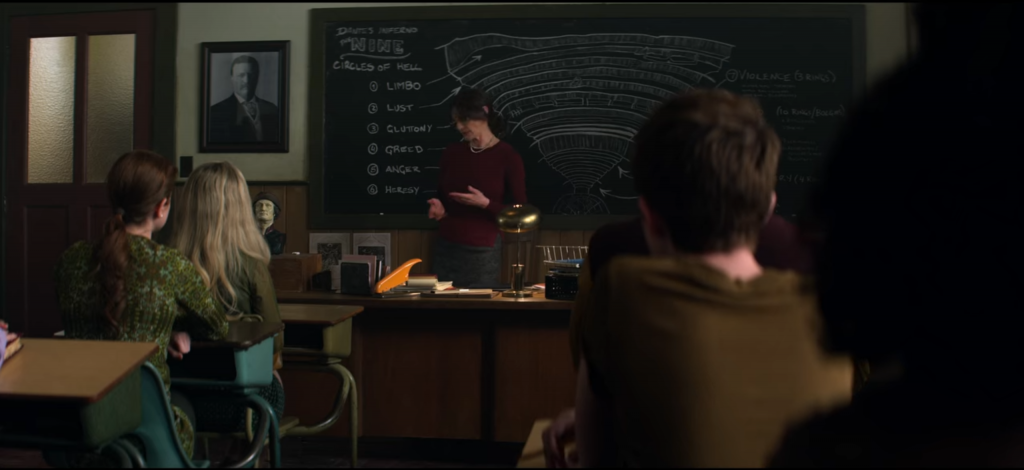
When I first saw this scene, I didn’t think too much about the image on the blackboard but it did look familiar. That is when I realized the chalk art was taken from Renaissance master, Sandro Botticelli. Most know him as the painter of beautiful religious and mythological pieces, such as Adoration of the Magi or Birth of Venus. However, later in life he became close to religious reformer, Girolamo Savonarola, while simultaneously developing an interest in darker subject matter, for starters Dante’s Inferno.
14th-century Italian writer, Dante Alighieri, wrote the Inferno as the first section of his epic poem, The Divine Comedy. In the said first section, Dante and Virgil journey through the nine circles of hell. Botticelli’s illustration and its many minute details paint a dark image of the scenes witnessed along the way and, like the linear counterpart in Ms. Wardwell’s classroom, maps out which circle is reserved for whom, according to Dante. Ironically, Ms. Wardwell’s focus on this text foreshadows Sabrina and her crew’s own adventures through the depths of hell.
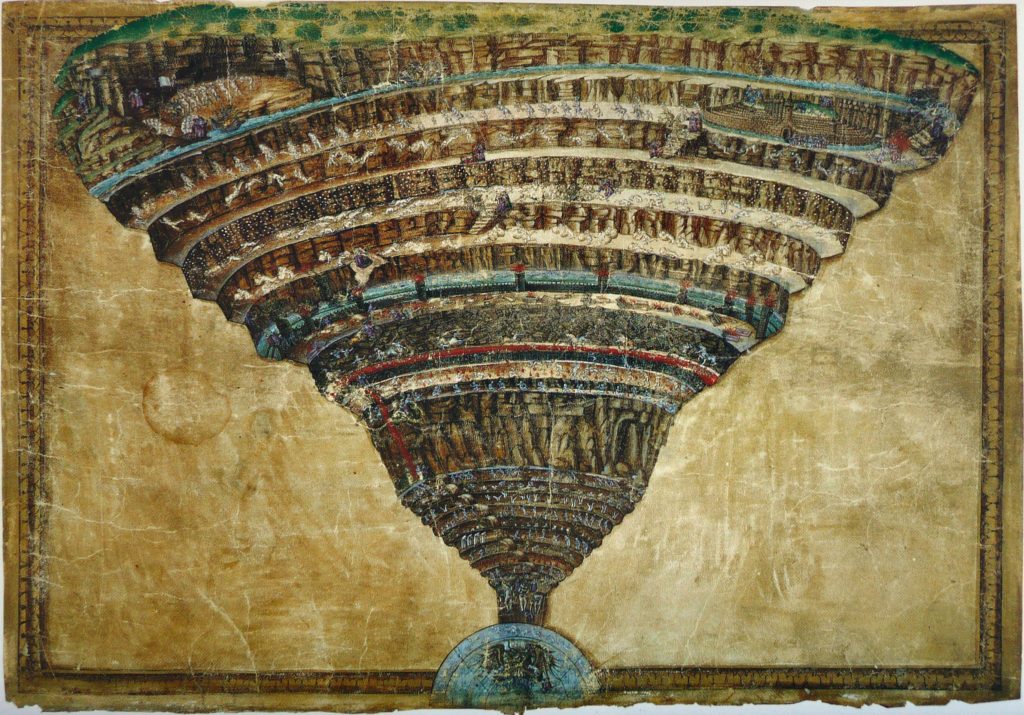
This funnel-shaped map that ends at the middle of the earth, or Lucifer’s – AKA Sabrina Spellman’s dad’s – home, was not the only hell-inspired image Botticelli created. In fact, this image was one of at least 92 others that were part of a larger commission from Botticelli by Lorenzo di Pierfrancesco de’ Medici for a lavish codex he called Commedia. The very small details have only recently begun to be decoded thanks to the powers of digital imaging.
One of Sabrina’s main missions in season three is to save her boyfriend, Nicolas, from Lucifer and Lilith’s clutches in hell. After unsuccessfully trying to open the gates of hell in Greendale’s mines, Ms. Wardwell’s words on paintings give Sabrina an idea: use paintings as portals to hell! Who better to contact for a portal hookup than the infamous art collector, Dorian Gray.
Enter the elusive, Netherlandish “madman,” Hieronymus Bosch, whose well-known, yet utterly odd visions of earth and the fiery depths come into play as said portals. Specifically, Bosch’s polyptych (multi-panel painting) Visions of the Hereafter. At first glance, this piece seems to portray a journey from hell to earth or vice versa, depending on the order in which you interpret them. Bosch’s intended message makes this polyptych a perfect portal to the netherworld.
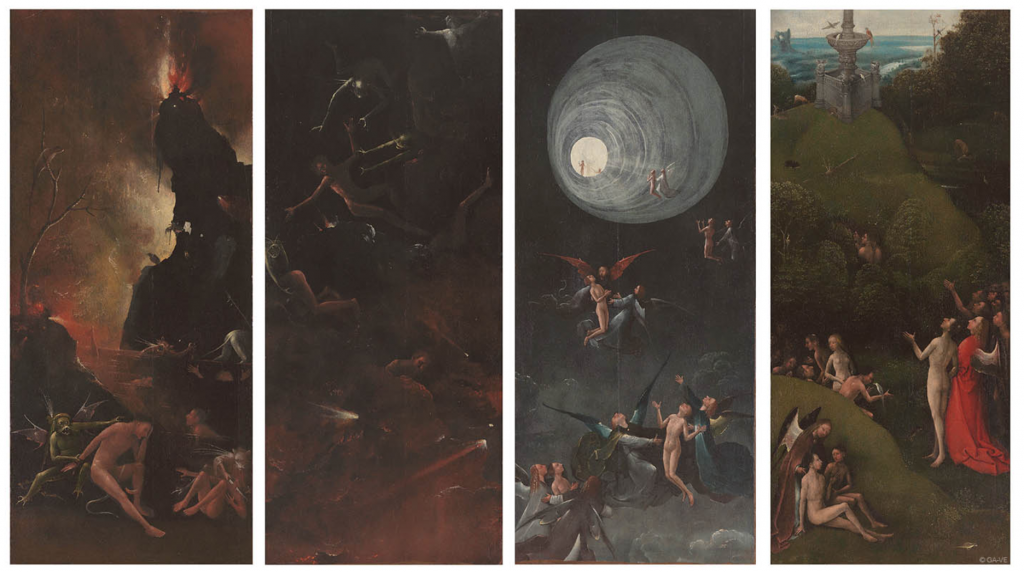
This group of paintings was once owned by Cardinal Domenico Grimani. According to scholars, it could have been part of a larger, more complex composition, perhaps pertaining to the themes of the Last Judgement. Here, Bosch has created four distinct stages of transcendence from Heaven, the more peaceful, garden-like panel, into Purgatory before finally landing in the fiery depths of Hell. That is, if we’re reading these from right to left. The man of the hour, Dante, may have inspired Bosch given that his text was translated in 1484 in Bosch’s hometown.
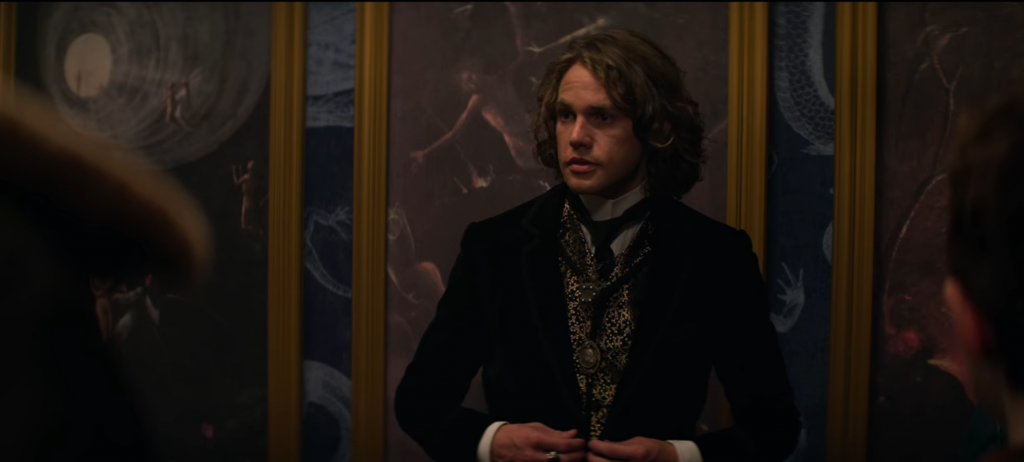
Sabrina’s next painting-portal comes about in Season Three, Episode Five. Fearing her own powers are too weak to carry her between realms, Sabrina consults Lilith, her regent of Hell, on how to get to Golgotha. The mission? Find Pontius Pilate’s bowl before Caliban in order to assure the condescending Kings of Hell of Sabrina’s abilities to maintain her role as Queen of Hell. In order find the bowl, she and Lilith, quite naturally, step through a portal found in a portion of another painting, Pieter Bruegel the Elder’s, The Triumph of Death.
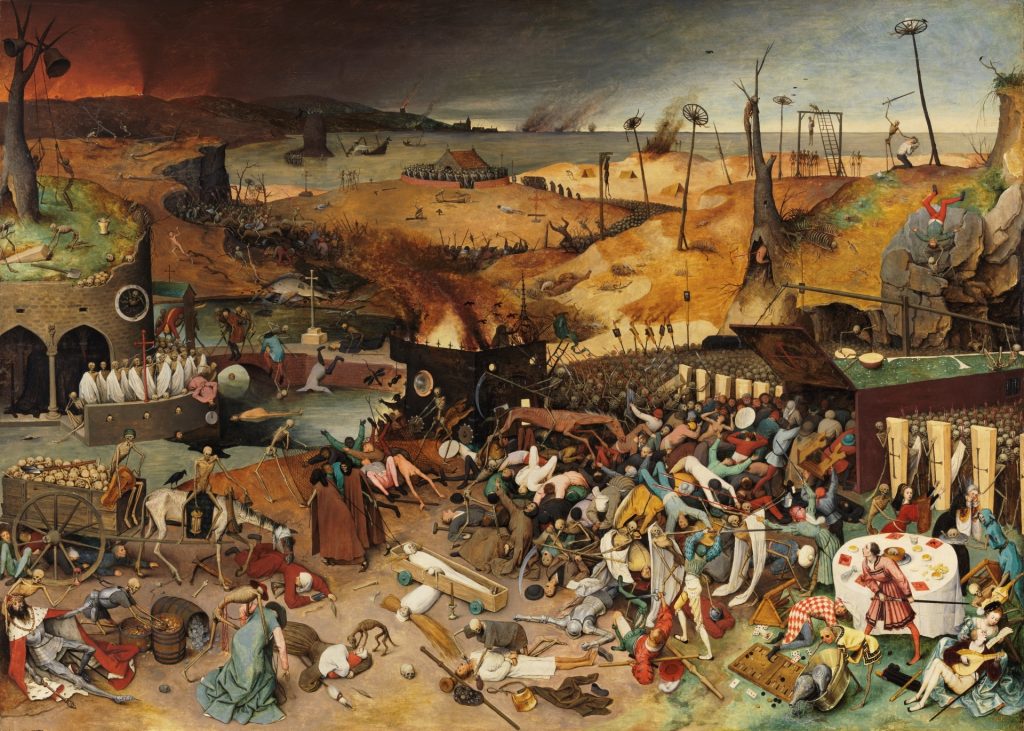
Not a lot is known about Bruegel, including how to properly pronounce his name (Bruegel or Brueghel; Broy-hel or Brew-hel). Even his origins are unclear, but it can be said that he was born sometime between 1525 and 1530 in either Breda or Antwerp. As for his painting, there are many things that set Pieter Bruegel apart from his contemporaries, such as Bosch. One main factor is his focus on human activity, as seen in the chaos above.
In Bruegel’s lifetime the Dance of Death was a popular theme among Northern artists. It began in medieval literature and Italian painting, although it was better known as the Triumph of Death. Bruegel gently reminds us that death conquers all by rendering a seen of apocalyptic chaos. Near the center, we see death atop his emaciated horse, leading his armies as they destroy the world of the living. As you take in the rest of the painting, you’ll see skeletons beheading, hanging, and escorting humans to their death – note the giant coffin on the right side. If it wasn’t already clear, the overarching moral of this work is that death inevitably comes for us all. Cheery, right?
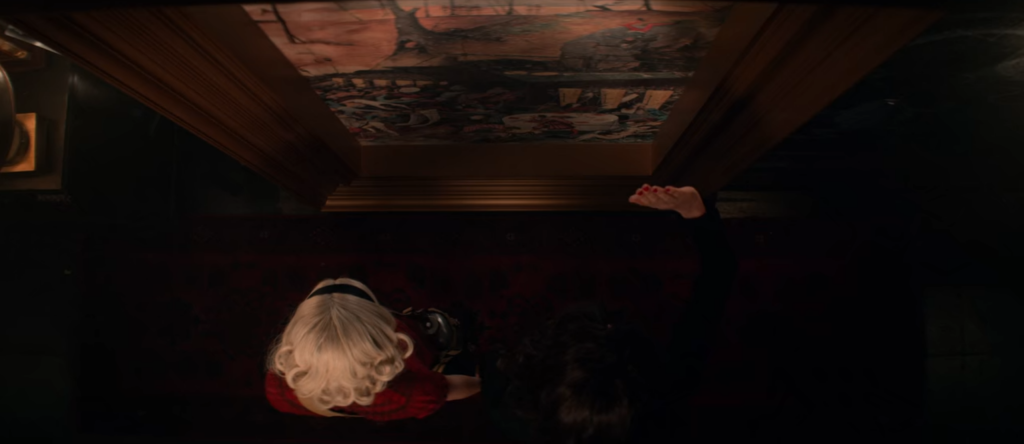
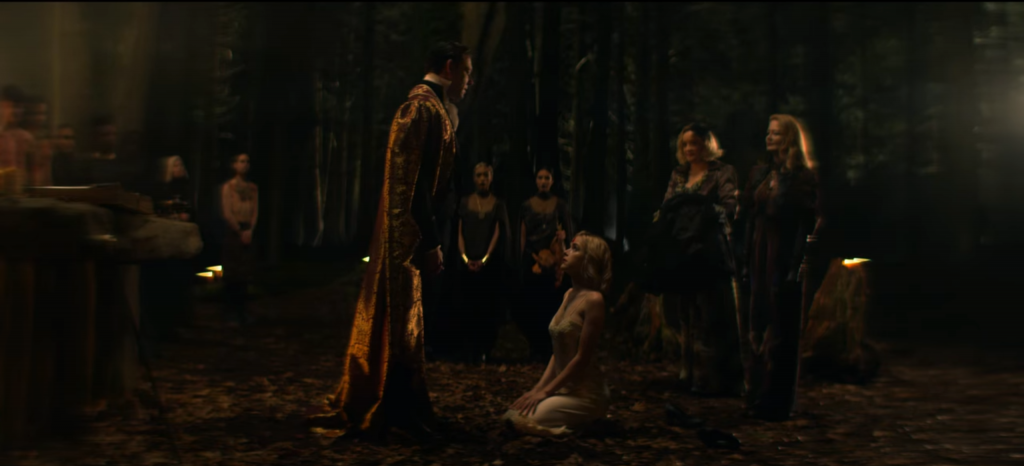
During Season One, we meet a young Sabrina, who is torn between following through with her Dark Baptism to become a witch or to decline and continue to her normal, mortal life with her friends. On her 16th birthday, Sabrina takes the plunge and signs the Dark Lord’s book. The ceremony takes place in a dark forest where many shadowy figures are in attendance.

It has been said this scene was inspired by Spanish artist, Francisco Goya’s, painting, Witches’ Sabbath or The Great He-Goat, which depicts the witches’ sabbath. In his later years, Goya contemplated the effects of power on humankind and portrayed it in a series of murals he painted in his cottage, La Quinta del Sordo. In this painting, Goya uses the world of witchcraft to criticize the degradation of humankind.
While the differences and similarities are clear, Sabrina’s ceremony has moments where it feels more empowering but also those where she is incredibly vulnerable and scared. While the photo above does not show the Dark Lord, he does make an appearance later in this sequence and his costuming is eerily similar to that of Goya’s painting.
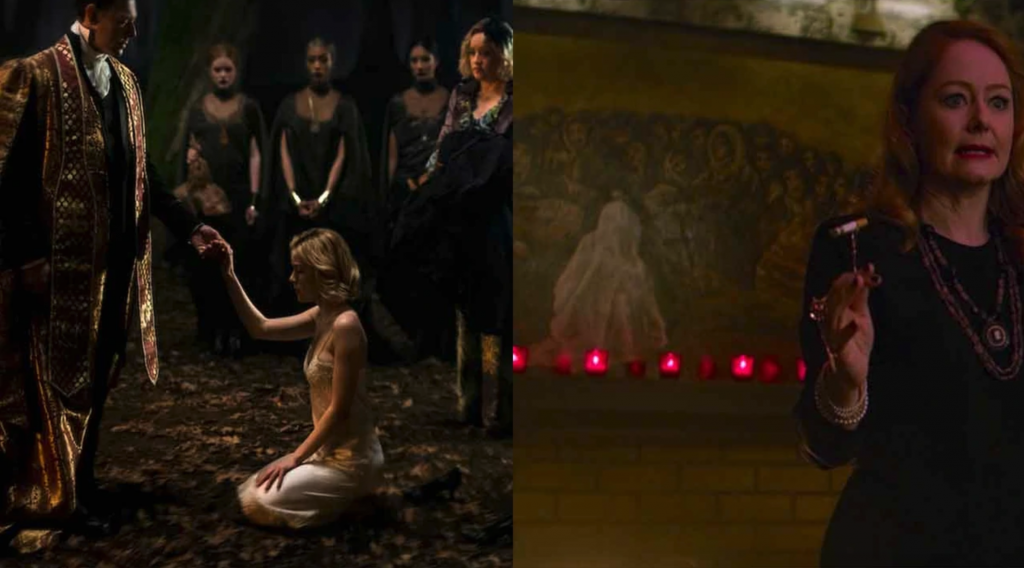
Somewhere in the Spellman Mortuary, I believe the living room, hangs a reproduction of Goya’s painting! While this may seem a conspicuous choice to have in your living room, the home is designed to be more normal in the front areas where Hilda, Zelda, and Ambrose would receive customers. Towards the back, the décor is noticeably different.
In the final season of The Chilling Adventures of Sabrina, Father Blackwood unleashes the Eldritch Terrors on Greendale. Of course, Sabrina and her crew leap to action to protect the town. The last of the eight terrors they face is The Void. After being warned by her other half and Queen of Hell, Sabrina Morningstar, Sabrina enters The Void on her own in order to trap it in Pandora’s Box.
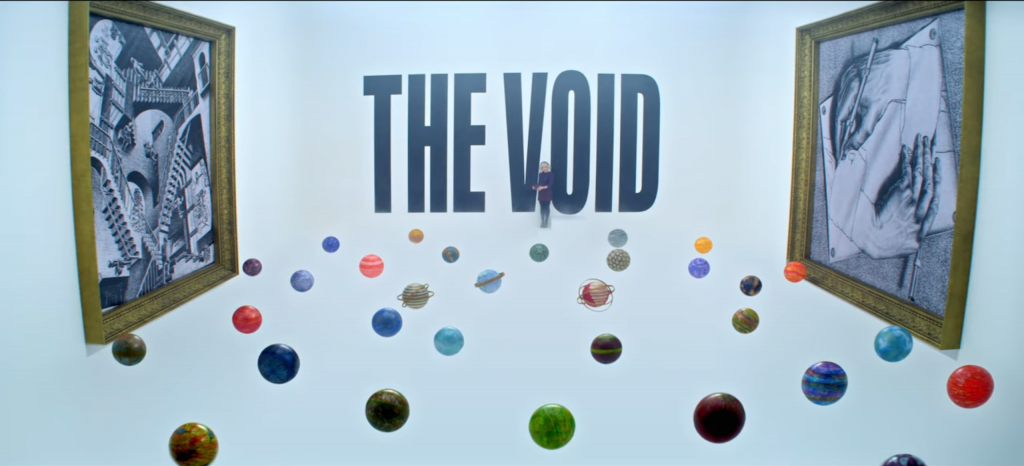
Upon her arrival in The Void, she finds a white room littered with planets and realms it has sucked in. On three of the walls hang two lithographs and one woodcut by the famous Dutch printmaker with a penchant for commenting on the human condition, M.C. Escher. Ladies and gents, this is where things get freaky. I suggest grabbing your brain if you happen to have recently misplaced it.
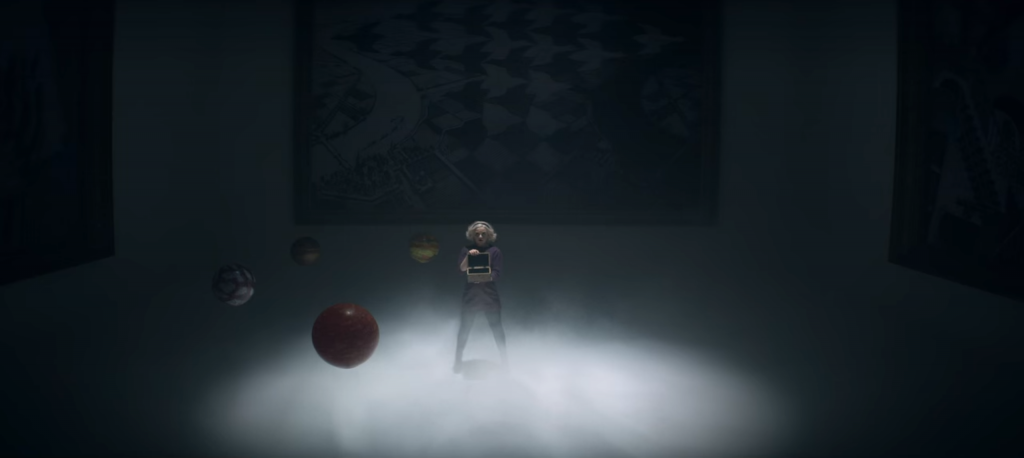
I’ll admit, I had an art-nerd moment when I saw Escher’s prints in this episode. He was largely dismissed by the art world, yet respected by mathematicians and scientists. His surreal, optical illusions are well known but many would likely fail to tell you his name. At first, it struck me as an odd choice to adorn the walls of a space like this but simultaneously, it made sense. Each print can be interpreted as its own visual metaphor, challenging your perception of reality. In the same instant, they also describe and criticize the space in which they exist. In real life, these prints are sizable but not huge. When Sabrina encounters them, they are gigantic, which puts these ideas even more in your face.
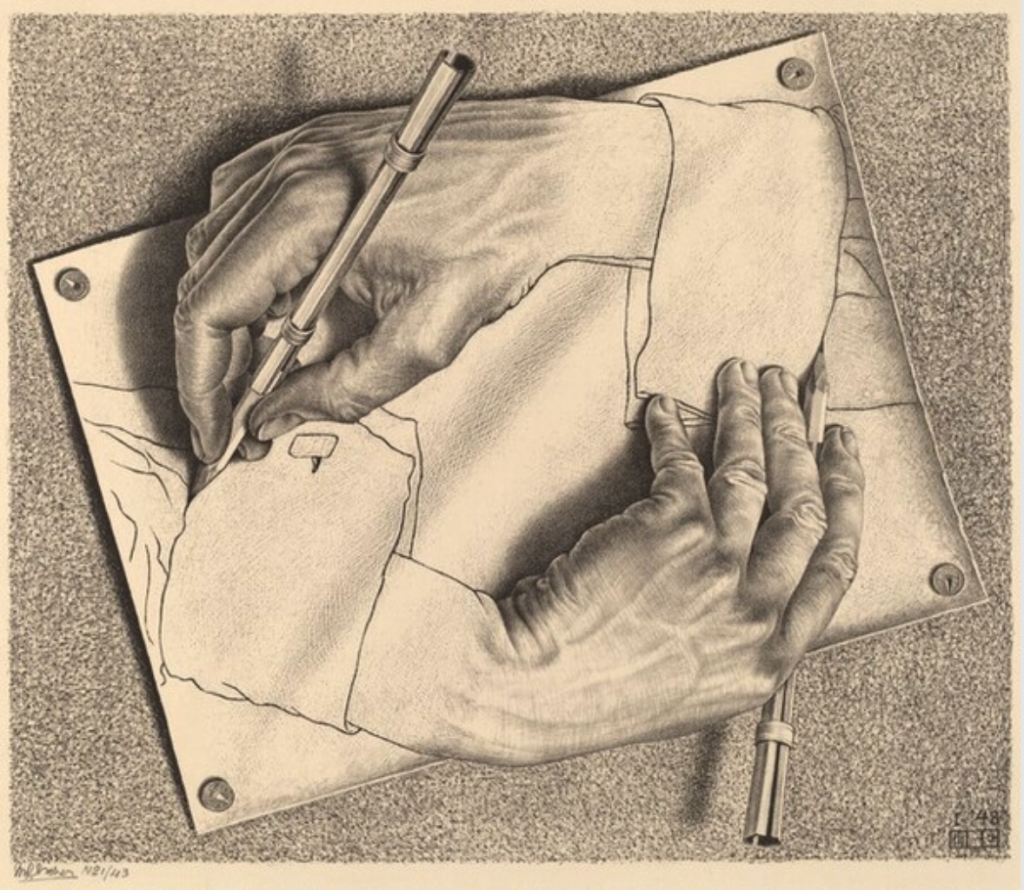
Escher was fascinated by paradoxes. Drawing Hands fluidly illustrates one of his favorites; the two-dimensional flatness of a sheet of paper or canvas and the three-dimensional, artistic illusion created on said surface. In Escher’s print, both flat and voluminous forms coexist and seem to create each other, challenging you to think about art itself as an illusion. In Sabrina’s realm this translates to The Void being the alleged blank canvas. Yet, even in its nothingness, it contains things, namely realms, Sabrina, and eventually, several others. Maybe it calls into question whether or not The Void, itself, is what it claims to be.
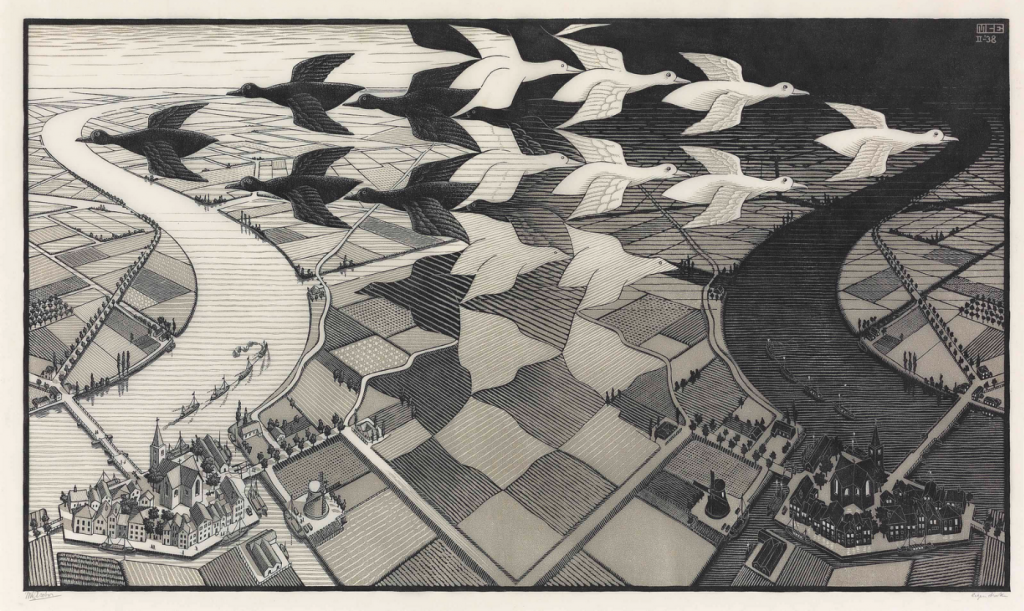
After visiting Spain’s famous Alhambra and viewing its patterned tiles, Escher became fascinated by tessellations, interlocking images that can be repeated indefinitely. In Day and Night, Escher uses tessellation to create a landscape illustrating an impossible reality: the seamless coexistence of day and night. When we see this in The Void, and consider The Void to be a type of underworld, as Sabrina does, we can interpret the dark side as death and the other as life. Perhaps Escher’s coexistence is valid between the living and the dead or perhaps the afterlife is more normal than we might think.
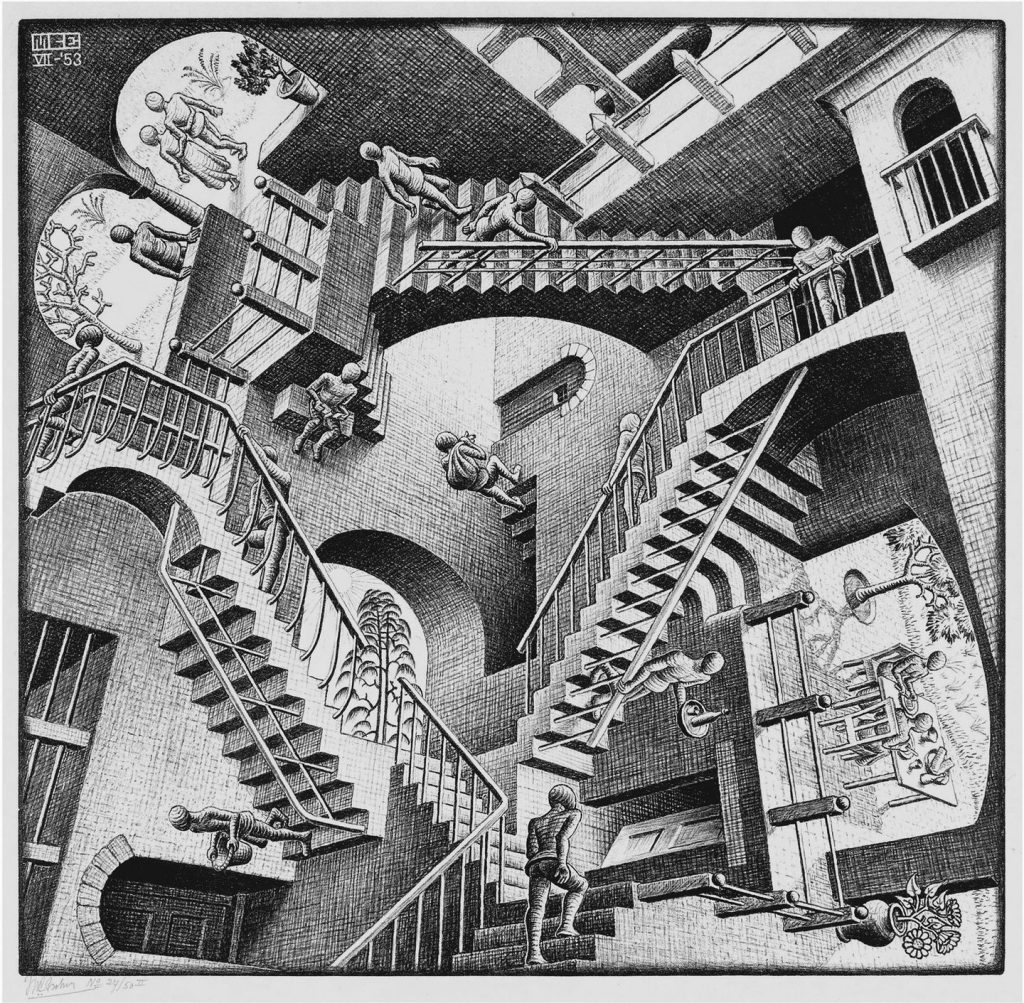
In the third Escher print, Relativity, the artist’s knack for visually commenting on the human condition comes to play. As was common in Escher’s work, he depicted his humans as indistinct, robotic forms. These figures seem to go about their daily lives, with seemingly different applications of gravitational laws, without thinking too much about the peculiar, yet wonderful labyrinth they inhabit. Sounds a bit familiar, right?
But wait, it gets weirder! Even the title itself is a bit of a double entendre. Firstly, each robo-human’s task, perhaps even their own perception, of said labyrinth is relative to where they are within it. This echoes our own world; the paths we take and how we view our corners of the earth depend on our experiences and surroundings. Secondly, if we take a look at the bigger picture, Escher’s title reflects his cunning use of multiple perspectives. Depending on if you tilt your head left or right or stand on your head, what you see will be different. It is as if he is creating an overarching metaphor, stating that “good” art is relative to the viewer. As they say, “beauty is in the eye of the beholder.”
To sum up that round of the mental Olympics, Escher’s prints were a brilliant choice for this series. While the prints are on the smaller side in actuality, the reproductions in The Void are gigantic. It is as if these visual metaphors are staring Sabrina and viewers directly, unavoidably in the eye. Perhaps it is a not-so-subtle hint that the themes we see in the various fictional realms we indulge in to escape the perplexing and sometimes frightening realities of our own lives, do exist.
Spoilers ahead!
In order to save her town as well as her family and friends, Sabrina knowingly sacrifices herself. In the end, the cold, seemingly lifeless Void transforms into a warmer realm, The Sweet Hereafter. Here the three Escher prints are replaced by three paintings, all bearing a common theme.
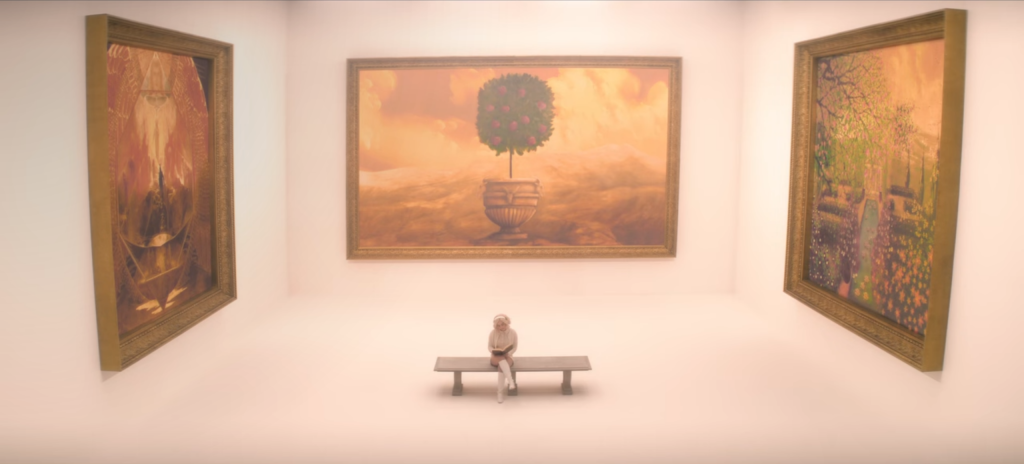
Of these three paintings, I was only able to identify the artist of one, the painting on the left wall. Reginald Machell was a 19th century English painter, wood carver, and theosophist. He was best known for his portraits however, due to his involvement in the Theosophical Society, had interests in a variety of faiths that show in his later paintings. One such painting is The Path, which we see in the final episode of The Chilling Adventures of Sabrina.
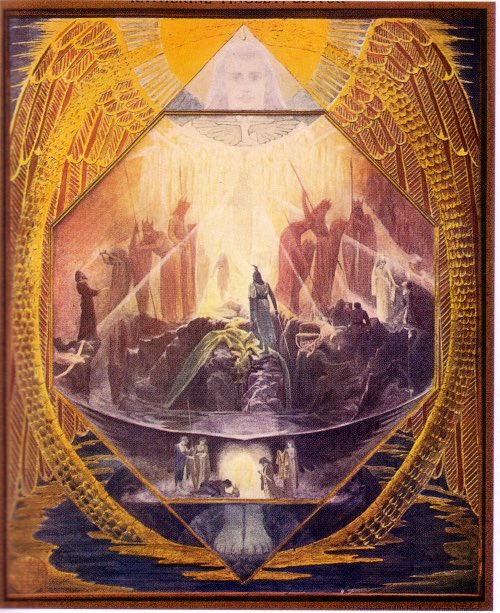
Machell described this painting as:
The Path is the way by which the human soul must pass it its evolution to full spiritual self-consciousness. The supreme condition is suggested in this work by the great figure whose head in the upper triangle is lost in the glory of the Sun above, and whose feet are in the lower triangle in the waters of Space, symbolizing Spirit and Matter. His wings fill the middle region representing the motion or pulsation of cosmic life, while within the octagon are displayed the various planes of conscious-ness, through which humanity must rise to attain a perfect Manhood.
Description by the artist, The Path, 1895, in Reginald Willoughby Machell, Pasadena Theosophical Society From Blavatsky Collected Writings, Vol. XII.
While I couldn’t identify two of these paintings, they all contain more biblical imagery. From Machell’s piece illustrating the soul’s path to enlightenment, the tree bearing the forbidden fruit, or the garden which could potentially be the Garden of Eden from Genesis, each symbolizes a vastly different set of ideas than Escher’s prints. My best interpretation of this choice is that while we might adhere to different faiths, or have no religious affiliation at all, it is possible that we all will meet again in the same place.
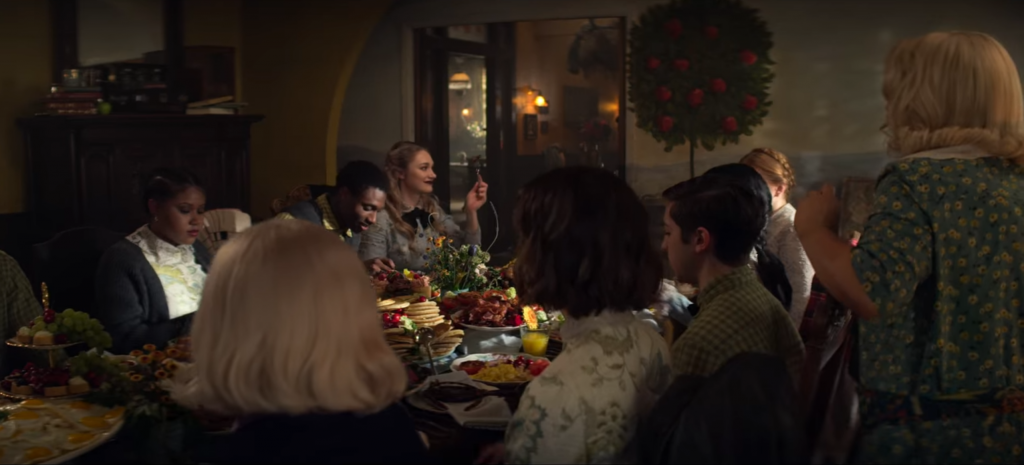
Oddly enough, the image of the tree appears again much earlier in the series. When Hilda and Zelda take in the Academy of Unseen Arts students at the beginning of Season Three, Hilda conjures up a full English breakfast for the kids. On the wall behind the head of the table, we see a mural featuring the same tree seen at the end of Season Four. Throughout the show, nature is a central theme that symbolizes rebirth and nature reclaiming its own. Perhaps the tree has no Biblical significance but relates back to this central theme.
If you’re a fan of horror, you may have noticed a few familiar items in The Academy of Unseen Arts. The Chilling Adventures of Sabrina features over 150 original paintings by Clive Barker. In Aril 2018, Barker hosted a viewing of his work for the show’s designer, Lisa Soper, in hopes his work could help create the dark, alluring atmosphere at the Academy. Barker was generous enough to loan his paintings to be hung on a rotating basis on the set. If you look closely, you’ll see them in shots of the Academy classrooms.
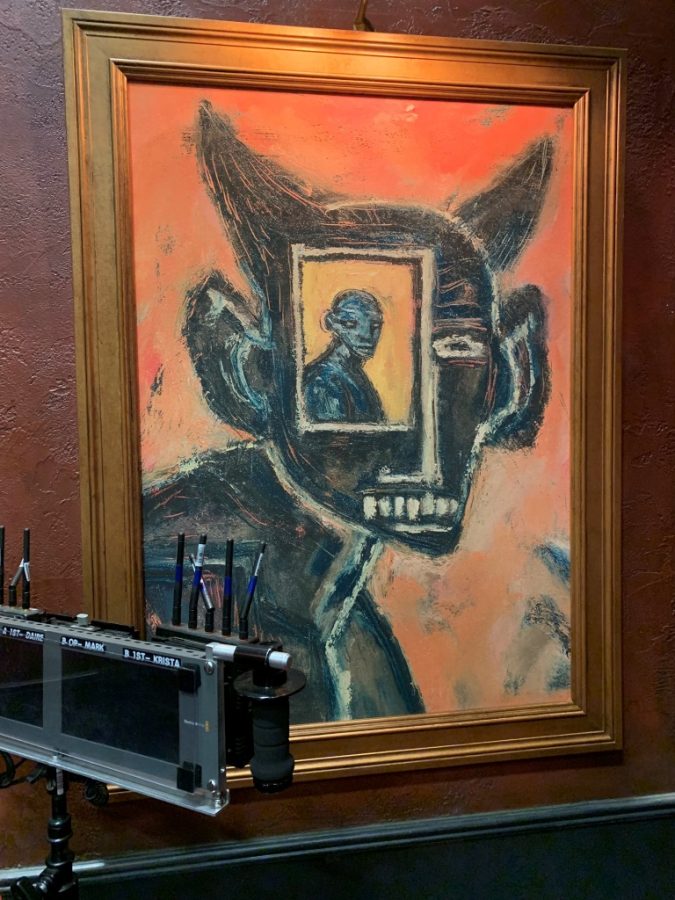
If you’re familiar with Clive Barker’s work, Ms. Wardwell’s cottage might look familiar! This is because the flooring, stained glass, and wallpaper were all inspired by Hellraiser. Those aren’t the only Barker Easter eggs hidden throughout the show, so keep your eyes peeled!
There were tons of hidden gems in this series. If you noticed that I missed one or can help identifying a piece, please leave a comment!
DailyArt Magazine needs your support. Every contribution, however big or small, is very valuable for our future. Thanks to it, we will be able to sustain and grow the Magazine. Thank you for your help!